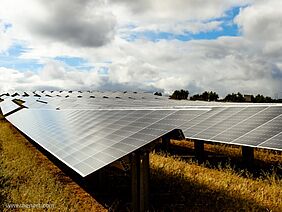2D materials are a promising and fairly new technology used in the field of solar photovoltaics. They have very good optical and electronic properties, a necessary feature when you want to develop advanced solar cells and other optoelectronic devices. 2D materials are, as a rule, more stable than commercial 3D materials and have great exciton binding energies. However, despite their efficiency in converting sunlight into energy, they have not yet found widespread commercial application as one of their weak spots is high sensitivity to moisture which affects them in a negative way.
Now (2021), scientists at Rice University have managed to advance the design and resilience of very thin solar cells consisting of semiconducting perovskites, which led to an increase in their efficiency as well as improvement of their ability to withstand environmental influences. They found that the sunlight itself was able to contract the space between the extremely thin atomic layers in the perovskites. The photoactive material in the solar cell was exposed to simulated sunlight while the temperature was kept constant, which made it possible to observe the minuscule contractions at the atomic level. These contractions allowed the material to transmit a current and therefore increased its photovoltaic efficiency by almost 18%. The researchers also found that placing a layer of organic positive ions between the iodide on top and lead on the bottom also enhanced interactions between the layers. These findings were confirmed by the ultrabright X-rays of the Advanced Photon Source (APS) at Argonne which were used to capture the structural changes in the material in real time. These “operando” studies helped the scientists analyse the material while it was undergoing controlled changes in temperature and environment under normal operating conditions.
Solar cell efficiencies of various cell technologies (including both single-crystal and thin film technologies) as tracked by NREL. Public Domain.
To ascertain that it was really the light which caused the contractions the scientists also carried out a control experiment where they deliberately kept the room dark, raised the temperature and waited for the opposite effect to occur: the expansion of the material. The final outcome of the experiment showed that if exposed to a solar simulator at one sun intensity for 10 minutes, the 2D perovskites contracted by 0.4% along their length and about 1% top to bottom.
The field of 2D perovskite structures and its application in solar photovoltaics has received a lot of attention lately. In 2018, scientists researched the electronic and opto-electronic properties in a layer-edge device of 2D perovskites. The dark and photo currents were shown to be highly dependent on the orientation of the crystals in the layer-edge device, while the anisotropic properties as well as photo response were influenced by the thickness of inorganic layers. Also, due to the abundant hydroxyl groups, water molecules could easily condense on the layer-edge surface, and the conductance was very sensitive to the humidity of the environment.
Layer-edge device. a Schematic diagram of layer-edge surface of 2D perovskite (HOC2H4NH3)2PbI4. Blue arrow and red arrow between electrodes indicate the direction of layer-edge 90° and 0°, respectively. b Top view of layer-edge surface.
Source: Bin Cheng, Ting-You Li, Pai-Chun Wei, Jun Yin, Kang-Ting Ho, José Ramón Durán Retamal, Omar F. Mohammed & Jr-Hau He/ Layer-edge device of two-dimensional hybrid perovskites/ NATURE COMMUNICATIONS. (2018) 9:5196 | DOI: 10.1038/s41467-018-07656-2/ Open Access This article is licensed under a Creative Commons Attribution 4.0 International License.
In 2020, scientists researched the power conversion efficiency (PCE) of 2D perovskite solar cells (PVSCs) and showed that it was greatly increased from 3.01% to 12.19% by the addition of lead(II) bromide. The scientists believed that the enhanced efficiency was due to a superior surface quality, enhanced crystallinity, and the resulting reduced trap-state density. They also found that devices incorporating lead(II) bromide without encapsulation had very good humidity stability, illumination stability, and thermal stability.
There are many benefits to using 2D perovskites: one of them certainly is that they usually have organic atoms which are able to block humidity, are thermally stable, and can solve ion migration problems. Also, an intended major upgrade of the APS will increase the brightness of the X-rays up to 500 times which will make it deliver even sharper pictures and thus make it easier to discern structural changes. That could help team modify the materials for even better performance.
The scientists are positive that they will be able to achieve efficiencies even greater than 20%, once they gain deeper insights into 2D materials. This would start a process where they could be used in combination with 3D perovskites or silicon solar cells and finally launched onto the market.
